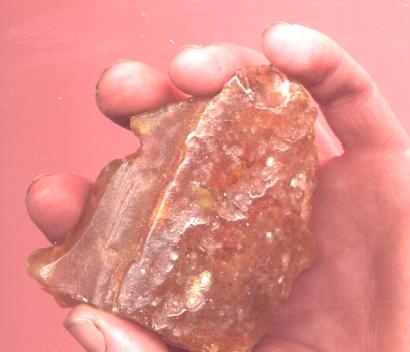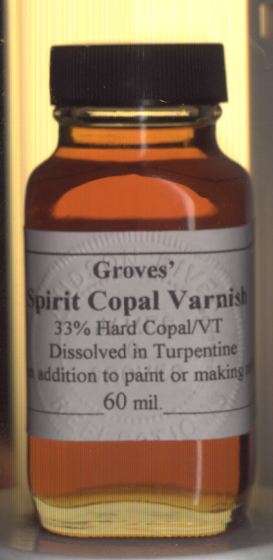
Here is a large chunk of Santander hard copal. It is very old and much stronger than soft copals, like Manila, Pontianac, or other freshly tree-gathered copals. In some ways, Santander is more difficult to dissolve into hot oil than Baltic Amber.

Copal and Rosin Spirit Varnish

Once fused into a brittle colophony, copal can be dissolved into gum turpentine or other spirit carriers to make fast evaporating copal coatings, such as a final tough picture varnish. Much tougher than dammar or mastic, hard copal picture varnish, termed "picture copal" by the 19th century painters, came into wide use. This varnish is not available today.
Aside from the common method of initially heat-fusing the hard copal resin, which typically makes a darker product, there are other tricks to getting it to dissolve into spirits. One very old method that arrives down from the 1600's is to dissolve the hard copal into hot Venetian Turpentine, thus combining the two. This combination in no way harms the final spirit varnish.
The Santander is recognized by some geologists as possibly the oldest Copal yet found on Earth. Others believe it is not older than a thousand years. Carbon dating some samples show it to be hundreds of years old, though carbon dating resins is not a certainty. However old the Santander is, I know this: a great heat is required to combine this Copal with the VT.
Aging fresh varnishes is important. Know that all copal, amber, or other varnishes, improve with age. They become stronger in their superadded effects. Typically, a good three-month waiting period helps the varnish become stronger. Once aged, the Santander hard varnish performs like any commonly available but soft resin spirit varnish--like dammar-- in that it produces stiff short paint. As the spirit evaporates, brushing of the paint becomes very sluggish. This varnish does not speed the drying of the paint in any way; it just makes it stiffer and causes it to "set-up" as the turpentine essence evaporates. Thus, it is perfect for rugged impasto underpainting and storage of paint into tubes or bladders.
Again, during the 19th century, copal spirit varnish was known and sold widely as "Picture Copal Varnish", or "Picture Copal" (to illustrate toughness, one British spirit copal coach varnish was known as Birmingham Varnish and contained no oil in its make-up). By contrast to "Picture Copal", the copal varnish made by combining the copal resin with oil was known as "Oil Copal". For painting purposes, artists were advised to use the Oil Copal type, and reserve the Picture Copal for final varnishing. However, realize the manufactured paint coming to the artist in bladders, and then later, tubes, typically had a shelf-life extender added to the mix. This extender was often a simple pine spirit varnish added in tiny amounts to keep the paint from drying out and making it buttery in consistence. Picture copal performs this shelf-life function beautifully. It can also be added in small amounts to various painting mediums to promote certain effects. Taubes advised its use in the first and second layers of oil paintings. The final layers would utilize the "oil copal" type, as it was fexible due to its oil-content.
Unlike pine spirit varnishes, "picture copal" made by my own VT/Copal method becomes very strong in a few weeks after application, and cannot be scratched with the fingernail. I think of it as a liquid hard copal resin. Apply it to any surface and that is then protected by a thin layer of tough transparent copal resin. Considering its make-up, the VT ingredient seems to have no substantantial softening effect; in fact, the resulting varnish is amazingly strong.
Note: About varnishing paintings: Freshly completed painted works CAN be varnished by scrubbing on a super-thin coat of the same varnish-added painting medium utilized within the actual paint (in other words, an oil copal medium, or oil amber medium-- not the pure oil varnish itself-- can be used. Be aware, turps might best be left out of any such medium, as it might dissolve thin glazes and scumbles). Contrary to popular thinking, it is only necessary to wait for the painting to dry tack-free before this final gloss or sheen-giving application. However, this thin varnishing must be performed before the work ages three weeks. After that time, if the work was not varnished by use of the medium, it should set for some 5 + months before coating with a spirit varnish. Such a later spirit varnish application would not be necessary had the freshly-painted work been given the slight coating of amber or copal medium. Note: again, after any thin final application of the medium, the work may be set in sunlight for about an hour to promote fast drying. Also again, as stated elsewhere on this site, amber and copal mediums should be composed of the varnish and only pure un-refined walnut oil. No vitamin E is allowed and no chemical purifiers, as such agents interfere greatly with the properties of the natual product.
Visit our Mediums page for our artist's hard "oil copal" varnish.
James C. Groves
Click here to visit our Gallery page.
jamescgroves.com